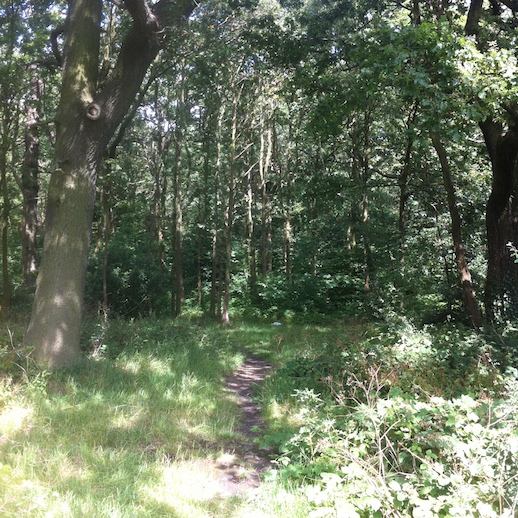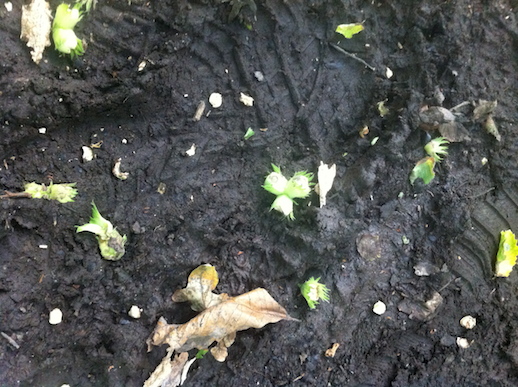Words and pictures by Emma Warren
The rain is coming down, torrentially and the woods look as if they’ve been sprayed all around with water vapour. It is so wet and misty that you could mistake what we’re seeing for tropical rainforest. Usually when the weather’s like this the trees are bare or at least golden, but here are chestnut and oak in full green, the air between them holding sheets of moisture that haven’t quite reached the ground. Even the nutty parakeets have gone quiet as we skim around newly-formed mud puddles.
It turns out that puddles are one of the unexpected threats to south London’s remaining slab of ancient woodland. The bridle path through Oxleas is broad, like a wide European boulevard but it’s compacted by walkers, animals and mountain bikers. Fat, grubby oases appear in wet weather reaching both sides of the path. Most people walk around them, bar teenagers and toddlers, who ninja-leap or stop and splash, and the paths encroach incrementally into the woods proper. It’s not quite Gallions Crossing, where the corresponding increase in traffic will probably require a massive road through this Site Of Metropolitan Importance For Nature Conservation, but it’s one of those things you’d never think about until you dig a little deeper into the ecology and life of the woods.
Jonathan Bangs is Greenwich Council’s Parks Outreach Officer and Oxleas falls under his remit. He found his ecological feet at the Newbury Bypass road protests in the 1990s and went on to work as a radio journalist, reporting on environmental stories for the BBC and Radio Thamesmead. After a stretch working in forestry in Hampshire he came back home and started working for Bexley Borough. The job was pleasingly straight-forward: “Here’s your Land Rover,” he says, in his maroon Parks Department polo shirt and reflective sunglasses, one warm August afternoon. “Go and look after your meadow.”
The arboricultural section is in-house and makes money by subbing itself out to streets and schools who would otherwise pay a non-council company to do any work. “A tree comes down here,” says Bangs, pointing to Jack Wood, “and unless it’s dangerous, it’s an expenditure. The policy is to leave deadwood where it is.”
It’s not just a money thing – decaying trees make an excellent habitat for insects and other organisms like the bracket fungus that you’ll find in the dark, damp deadwood. Fallen trees are a cross between home and larder; a silent restaurant with beds out the back.
A few days later the Greenwich Council management plan for Oxleas drops into my in-box. It was written in 2008 and is full of fantastic environmental detail and colour. The seasonal streams that criss-cross the woods support plant life with names like obscure progressive rock bands: hairy wood rush, remote sedge and giant fescue. The alder wood on the damp northern edge provides perfect growing conditions for wild angelica and pendulous sage. It’s wet down there because of the severity of the slope: the lowest corner of this tea-tray shaped section of the woods tips down to 70m above sea level compared to 120 meters above sea level up at the top. The document also contains a neat indication of how times have changed: “When Oxleas Woodlands was managed by the GLC, senior parks staff carried air rifles and used them to cull grey squirrels early in the day. This practice would not be considered appropriate now.”
It’s a hot day right at the start of the month and I’m off the main path so ducking under low chestnut branches and trying not to get stung or scratched up by brambles. There are tiny, verdant sweet chestnut coins on the floor, standing out like acid green flycatchers against the oily brown of this stretch of path. There’s a patch of woods that looks like it’s come straight out of Where The Wild Things Are: a cramped stand of skinny oaks with the trunks all packed in tall and tight and parallel and a bushel of leaf cover right at the top of the canopy. Patches of Oxleas were coppiced under the GLC back in the 1960s and I wonder if this is nature at work, regenerating.
The thing about the trees is that we can see what looks like a lifetime in just a year: new growth, a blossoming, a slow burnished decline and then death. They are like clocks, beating out time with two pulses: one we can see and one that only reveals itself over generations. If fruit flies were sentient I imagine they’d feel the same way about us.

